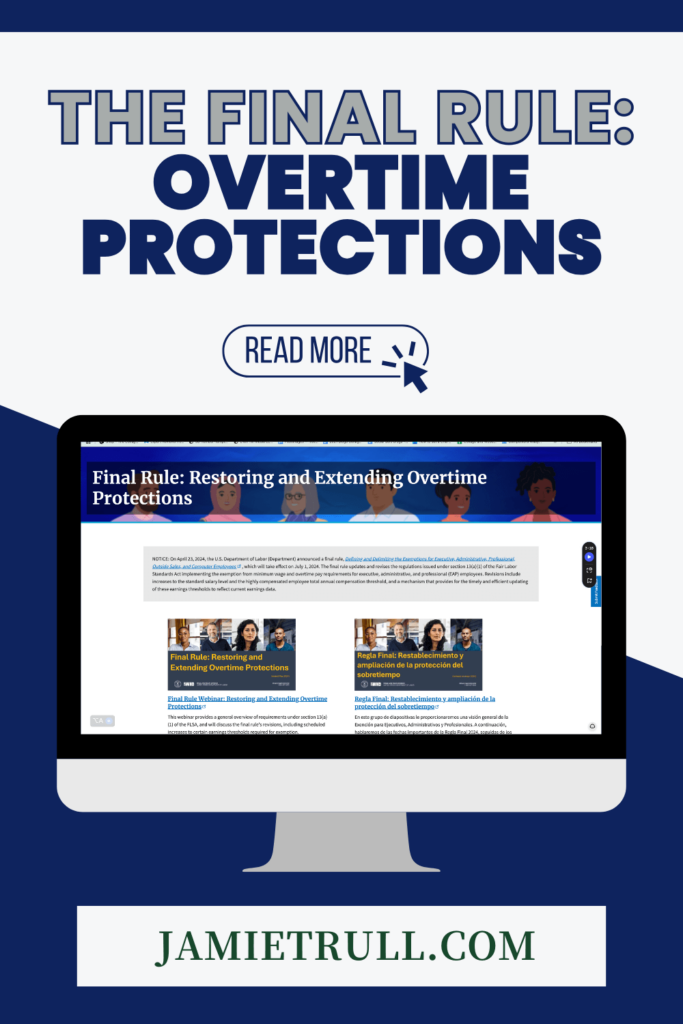
If you run a business with salaried employees, there’s a critical update from the Department of Labor (DOL) regarding the new overtime rule you need to be aware of. New overtime rules come into effect in July 2024, with additional changes planned for January 2025.
These changes might impact payroll requirements, your employees’ exempt status, and your business profitability. Below, we break down everything small business owners need to know so you can stay compliant and manage your bottom line effectively.
Overview of the New Overtime Rules
The new overtime rules, effective July 1, 2024, and January 1, 2025, aim to expand overtime protections for millions of workers. The rules increase the salary thresholds required to exempt a salaried bona fide executive, administrative, or professional employee from federal overtime pay requirements. The updated salary thresholds are as follows:
- $43,888 per year ($844 per week) effective July 1, 2024
- $58,656 per year ($1,128 per week) effective January 1, 2025
These changes will impact approximately four million new workers who will become entitled to overtime pay. Employers must review their exempt employee classifications and compare them against the new salary thresholds to ensure compliance with the Fair Labor Standards Act (FLSA).
What’s Changing in the Overtime Law?
The Department of Labor has revised the exemption threshold for salaried employees under the Fair Labor Standards Act (FLSA) with the new overtime rule. This law governs minimum wage, overtime pay, and other employment conditions in the U.S.
One major benefit of having exempt employees is that businesses don’t need to track their hours or pay overtime for more than 40 hours a week.
Under the current rules, employees earning $35,500 or less are considered non-exempt, meaning they are entitled to overtime pay.
New Salary Threshold Increases for Highly Compensated Employees
- July 1, 2024: New threshold increases to $43,888
- January 1, 2025: Threshold jumps to $58,656
This two-step increase is significant. If you have salaried employees earning between $35,500 and $58,656, you’ll need to assess whether to raise their salary to maintain exempt status or start tracking their hours for overtime pay.

Does This Impact My State?
If you’re in California, New York, Washington, or Colorado, these new rules may not affect you, since these states already have higher thresholds for exempt employees. However, for other states, compliance with the new federal standards will be essential.
How Could This Impact Your Business?
The DOL estimates that over four million employees will now qualify for overtime, with a projected $1.5 billion cost to employers nationwide.
For small business owners, this could affect:
- Payroll expenses: Changes to the employee’s salary thresholds may require you to pay overtime for more employees.
- Operational costs: Tracking hours for salaried workers who become non-exempt might require new systems or processes.
- Profitability: Without proactive planning, your profit margins could take a hit.
Next Steps: How to Prepare Your Business

Here are actionable steps to ensure compliance and maintain control over your business finances.
1. Review Salaries and Job Roles
Look at your payroll and identify employees earning between $35,000 and $58,656. You’ll need to decide whether to adjust their salaries or track their hours. This is also a good opportunity to evaluate if any roles should be adjusted, merged, or divided into multiple positions.
2. Implement Time-Tracking Systems
If employees are reclassified as non-exempt, you’ll need a way to track their overtime hours accurately. Investing in a simple time-tracking tool will ensure compliance with overtime rules and help you avoid any wage disputes.
3. Update Your Employee Handbook
This is a great time to update your policies to manage overtime. Consider implementing a rule that overtime requires pre-approval, so you can control additional payroll costs.
4. Plan for Possible Changes
With the new threshold being introduced by the Biden-Harris administration, there’s a chance the rule could face legal challenges or be revised after the 2024 election. While you should prepare for compliance, don’t make drastic business decisions based solely on these changes.
5. Optimize Profit Planning
To stay profitable amid these changes, it’s essential to monitor and adjust your financial strategy. Grab my PROFFIT™ Plan worksheet for free to help you set clear profit goals and align your business operations accordingly.
📈 Create your PROFFIT™ Plan here: Download our PROFFIT Plan™ Worksheet
Additional Resources to Help You Stay on Track
- More details from the Department of Labor: Learn more about the overtime law
- Create a Cash Flow Forecast for your business: Start forecasting today
Stay Ahead of the Curve
The new overtime threshold changes are a reminder that small business owners need to stay informed and adaptable. Take time now to review your payroll practices, communicate with employees about any changes, and explore strategies to maintain profitability.
With the right tools and planning, you can navigate these changes smoothly and keep your business on track.
Managing your payroll effectively means more than just complying with overtime laws—it’s also about keeping your business profitable.
Be sure to revisit your financial strategies regularly to stay ahead.
If you feel overwhelmed or unsure of where your business stands financially, watch my in-depth guide on how to get your business finances organized.
Watch this video from Jamie to learn more – New Overtime Compensation Threshold: What does it mean for your business?
This transcript is a direct copy from the original video, formatted for readability. No changes have been made to the original spoken content.
Have you heard of the new overtime compensation threshold? If you have salaried employees, this new regulation could impact your business. Today, I’ll walk you through what’s changing and how it could affect your payroll and profitability.
Hi everyone, Jamie Trull here, your go-to CPA, bringing you the tools and resources to stay informed, organized, and profitable. If you want to keep up with important updates like this, don’t forget to hit that bell icon and subscribe to the channel!
What’s Changing with Overtime Pay?
The Department of Labor (DOL) recently released new rules that redefine the salary threshold for exempt employees under the Fair Labor Standards Act (FLSA). This threshold determines which employees are exempt from overtime pay requirements.
Effective Dates:
- July 1, 2024: Threshold increases to $43,888.
- January 1, 2025: Threshold jumps to $58,656.
What Does Exempt vs. Non-Exempt Mean?
- Exempt Employees: Salaried workers whose pay is not tied to the number of hours they work and who do not receive overtime pay for hours beyond 40 per week.
- Non-Exempt Employees: Employees entitled to overtime pay, typically at 1.5x their hourly rate for any hours over 40 in a week.
Previously, employees making $35,500 or less were automatically classified as non-exempt. However, the new thresholds increase that limit to $43,888 in mid-2024 and $58,656 in early 2025.
Who Is Affected by the New Rule?
This change primarily impacts salaried employees earning between $35,000 and $58,656. If you have workers in that range, they may need to transition from exempt to non-exempt status.
Important note:
- If you operate in California, Colorado, New York, or Washington, your state already mandates a higher threshold, so this new rule may not affect you.
Impact on Small Businesses
This change is expected to affect 4 million employees and cost employers $1.5 billion. For small business owners, it’s essential to:
- Review employee salaries and reclassify roles if necessary.
- Update time-tracking processes if previously exempt employees become non-exempt.
- Adjust budgets to account for potential overtime payments.
Steps to Prepare for Compliance
- Review Payroll
Look at employees making between $35,000 and $58,656 and decide whether to increase their salaries or shift them to hourly pay with overtime eligibility. - Introduce Time Tracking
Implement tools to track hours accurately for any newly non-exempt employees. This will ensure compliance with overtime rules. - Update Employee Handbooks
Set policies requiring pre-approval for overtime to manage labor costs effectively. - Develop a Profit Plan
Use this as an opportunity to review your business’s financial health and plan for changes in labor costs.
👉 Create your PROFFIT Plan™: Download the PROFFIT Plan™ worksheet
Should You Make Big Changes Now?
Given that this rule was introduced during an election year and could face legal challenges, it’s wise to be prepared without making hasty decisions. Focus on what’s best for your business long-term, rather than reacting solely to regulatory changes.
How to Stay Ahead
If you need help understanding the impact of this change on your business, talk to your payroll provider or CPA. They can offer advice on compliance and payroll strategy.
Final Thoughts and Resources
If you want to dive deeper into the financial impact of these changes and develop better financial strategies, check out the following:
- More details on the DOL rule
- Create a Cash Flow Forecast